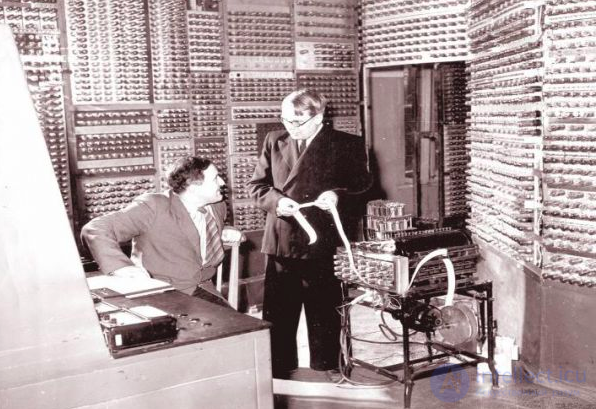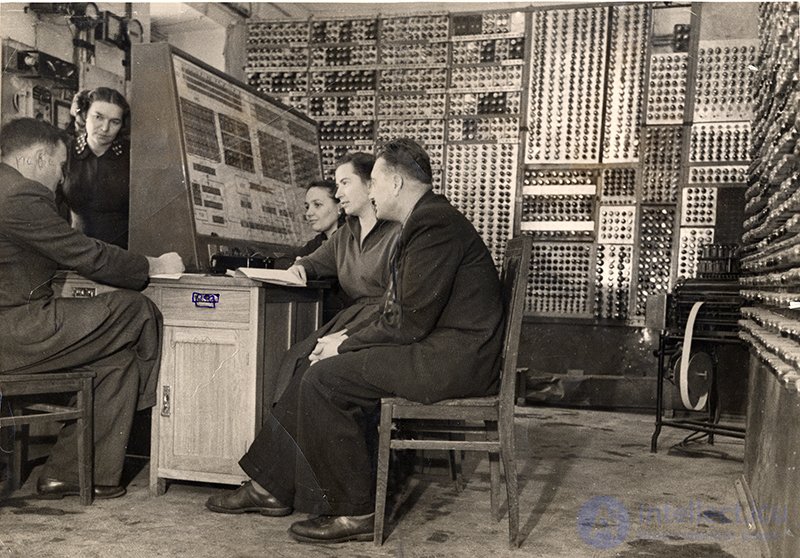Lecture
 In Ukrane, an eminent scientist, academician Sergei Alekseevich Lebedev, was at the origins of the development and formation of the domestic computing technology. As one of his students, Academician V. A. Melnikov, writes, “Sergei Alekseevich Lebedev’s life course is bright and multifaceted. In addition to creating the first machines and the first fundamental developments, he carried out important work on the creation of multi-machine and multiprocessor complexes. He laid the foundations of computer networks. Among the promising areas should be noted work in the field of operating systems and programming systems. Structural and software operating systems, algorithmic programming languages, new algorithms for large, time-consuming tasks are an important stage in Lebedev's scientific work. A number of his works, unfortunately, remained unfinished. In the main directions outlined by S. A. Lebedev, his students and entire scientific teams are working. The scientific school created by him is the best monument to a scientist. ”
In Ukrane, an eminent scientist, academician Sergei Alekseevich Lebedev, was at the origins of the development and formation of the domestic computing technology. As one of his students, Academician V. A. Melnikov, writes, “Sergei Alekseevich Lebedev’s life course is bright and multifaceted. In addition to creating the first machines and the first fundamental developments, he carried out important work on the creation of multi-machine and multiprocessor complexes. He laid the foundations of computer networks. Among the promising areas should be noted work in the field of operating systems and programming systems. Structural and software operating systems, algorithmic programming languages, new algorithms for large, time-consuming tasks are an important stage in Lebedev's scientific work. A number of his works, unfortunately, remained unfinished. In the main directions outlined by S. A. Lebedev, his students and entire scientific teams are working. The scientific school created by him is the best monument to a scientist. ”
Sergey Alekseevich throughout his life did a great job of preparing scientific personnel. He was one of the initiators of the creation of the Moscow Institute of Physics and Technology, the founder and head of the department of computing technology at this institute, and led the work of many graduate students and graduates.
Speaking about the legacy of S. A. Lebedev, one cannot but tell about the atmosphere of mutual understanding and creative inspiration that Sergey Alekseevich was able to create around himself. He was able to encourage creative initiative, while remaining principled and demanding. Lebedev believed that the best school for a specialist was to participate in specific developments, and was not afraid to involve young scientists in serious projects.
He was born on November 2, 1902 in Nizhny Novgorod. Father Alexey Ivanovich and mother Anastasia Petrovna were teachers.
In 1921, S. A. Lebedev entered the Moscow Higher Technical School. N. E. Bauman at the Faculty of Electrical Engineering. His teachers and supervisors were the outstanding Russian scientists in electrical engineering, professors KA Krug, L. I. Sirotinsky, and A. A. Glazunov. All of them took an active part in the development of the famous electrification plan of the USSR - the GOELRO plan. To develop this plan and, most importantly, for its successful implementation, unique theoretical and experimental research was required. Of all the problems that arose during this, S. A. Lebedev, while still a student, focused on the problem of the stability of parallel operation of power plants. And it should be said that he was not mistaken in his choice - all further domestic and foreign experience in creating high-voltage power interconnections defined the stability problem as one of the central ones, and the effectiveness of long-distance power and AC power systems depends on its solution.
The first results on the problem of sustainability, obtained by Lebedev, were reflected in his graduation project, which was carried out under the guidance of Professor K. A. Krug. In April 1928, having received a degree in electrical engineering, Lebedev became simultaneously a teacher at the Moscow Technical Technical University. N. E. Bauman and junior researcher at the All-Union Electrotechnical Institute (VEI). Continuing to work on the problem of sustainability, S. A. Lebedev organizes a group in the VEI, which then took shape in the laboratory of electrical networks. Gradually, the subject matter of the laboratory is expanding, and the problems of automatic regulation begin to fall into the circle of its interests. This led to the fact that, on the basis of this laboratory, in 1936, an automation department was created, the management of which is entrusted to S. A. Lebedev.
By this time, S. A. Lebedev had already become a professor and author (together with P. S. Zhdanov) a widely known monograph “Stability of parallel operation of electrical systems” among electrical specialists.
A remarkable feature of Lebedev’s scientific activity, which appeared from the very beginning, was the organic combination of a great depth of theoretical study with a concrete practical orientation. Continuing theoretical studies, he becomes an active participant in the preparation of the construction of the Kuibyshev hydroelectric complex, and in 1939–1940, S. A. Lebedev in Teploelektroproekt led the development of the design task for the transmission line.
SA Lebedev is interested in the problems of automation not only in relation to specific applications in electrical engineering, he is one of the active initiators of work on the automation of scientific research and mathematical calculations. In 1936-1937, work began in his department on creating a differential analyzer for solving differential equations. Even then, S. A. Lebedev thought about the principles of creating digital computers, which would be based on a binary number system.
During the war, the automation department headed by Lebedev completely switches to defense topics.
In February 1945, S. A. Lebedev was elected a full member of the Academy of Sciences of the Ukrainian SSR, and in May 1946 he was appointed Director of the Institute of Energy of the Academy of Sciences of the Ukrainian SSR. In 1947, after the separation of this institution, S. A. Lebedev became the director of the Institute of Electrical Engineering of the Academy of Sciences of the Ukrainian SSR. Here he continues his work on the automation of power systems. In 1950, S. A. Lebedev, together with L. V. Tsukernik, was awarded the USSR State Prize for the development and introduction of compounding devices for power plants to increase the sustainability of the energy systems.
In 1947, a modeling and computing laboratory was organized at the Institute of Electrical Engineering, where, under the leadership of S. A. Lebedee, an MESM machine (a small electronic counting machine) was created - the first domestic computer.
It is interesting to present the main stages of the development and launch of the first domestic computer:
The functional-structural organization of the SECM was proposed by Lebedev in 1947. MESM worked in a binary system, with a three-address command system, and the computation program was stored in RAM. Lebedev's machine with parallel word processing was a fundamentally new solution. She was one of the first in the world and the first on the European continent machine with the program stored in memory.
In 1948, the Institute of Fine Mechanics and Computer Engineering (ITM and VT) of the USSR Academy of Sciences was created in Moscow, where S. A. Lebedev was invited to work, and in 1950, when the main work on the MESM was about to end, Lebedev accepted this proposal.
The first computer in continental Europe was created in Ukraine more than 60 years ago in 1951. The first computer was called the Small Electronic Calculating Machine - MESM. Despite the modest word “Small,” it numbered 6,000 electronic lamps and barely fit in the left wing of the hostel of the former monastery village of Feofania, 10 km from Kiev. The machine was created in the laboratory of computer technology of the Institute of Electrical Engineering of the Academy of Sciences of the Ukrainian SSR under the leadership of Academician Sergei Alekseevich Lebedev.


Small electronic calculating machine MESM. Photo - 1951 Rear panel: L.N. Dashevsky and Z.S. Zorina Rapota. Behind the remote control from left to right: L.M. Abalyshnikova, T.I. Petsuh, E.E. Dedeshko National Academy of Sciences of the Ukrainian SSR, Kiev Small electronic calculating machine MESM. Photo - 1951 Rear panel: L.N. Dashevsky and Z.S. Zorina Rapota. Behind the remote control from left to right: L.M. Abalyshnikova, T.I. Petsuh, E.E. Dedeshko National Academy of Sciences of the Ukraine , Kiev
In ITM and VT, he creates a special laboratory for the development of BESM-1 (high-speed electronic counting machine-1), in which Lebedev's ideas on the structural implementation of information processing methods were further developed.
Academician V. A. Melnikov recalls: “From the experience of creating BESM-1 we can see the breadth of its scientific and engineering developments. In the processor of the machine were used lamps, mass-produced by our industry. Lebedev pointed out several directions for the creation of computer RAM. Work was underway to create a random access memory (RAM): on electroacoustic mercury delay lines; Parallel RAM on cathode ray tubes; RAM on ferrite cores. External storage devices on magnetic tapes and magnetic drums, input and output devices on punched cards and punched tapes, high-speed printing devices were created.
The BESM-1 was the first to use a permanent storage device on removable punch cards, which made it possible to solve problems as soon as a particular storage device was ready. Therefore, its actual use began in 1952 with RAM on electroacoustic mercury tubes. True, its speed was ten times lower than planned, but, in addition to solving problems, it became possible to get the first experience in operating and debugging programs. ”
It should be noted that BESM-1 surrendered twice: for the first time - from RAM to electron-acoustic mercury tubes with an average speed of 1000 operations per second and second time - from RAM to cathode-ray tubes with a speed of about 10 thousand operations per second. And both times it was successfully adopted by the State Commission. True, later there were still tests, when the BESM-1 was tested on RAM on ferrite cores, but this type of memory was already finally implemented on the BESM-2 serial car. BESM-1 was the first domestic high-speed machine (8-10 thousand operations per second), the most productive machine in Europe and one of the best in the world.
The first task, solved at BESM-1 and of great economic importance, was the calculation of the optimal slope of the canal. In the program for solving this task, the parameters of soil flowability, channel depths and some others were set. A steep slope saves earthmoving, but can lead to rapid shedding, so it is important to find a mathematically sound compromise that would save the amount of work while maintaining the quality of the structure. The work on creating the algorithm and program that required serious mathematical research was carried out under the direction of S. A. Lebedev, who in 1953 was elected a full member of the USSR Academy of Sciences.
In the structure of the BESM-1, even then, the main solutions characteristic of modern machines were implemented. The principle of its operation was a parallel operation, which required an increase in the equipment; and it was a bold decision at the time, for example, one trigger cell contained four electron tubes, the reliability of which was small, the service life was only 500–1000 hours, and in the BESM-1 there were more than 50 thousand such lamps.
An important feature of this machine and a great structural achievement were operations on floating-point numbers, when the machine can perform operations on numbers in the range of 2 ~ 32–232 automatically, without requiring special scaling operations. These operations in fixed-point machines account for about 80% of the total number of operations and increase the time to solve problems. At the same time, BESM-1 provided good accuracy of calculations (about 10 decimal places), and, while solving some problems, it could work with less speed, but with doubled accuracy.
After BESM-1, two more tube lamps, the BESM-2 and M-20, were created and put into production under Lebedev’s leadership. Their characteristic feature, writes V. A.4 Melnikov, was that they were developed in close contact with industry, especially M-20. Specialists of the plant and the academic institute together participated in the creation of the machine. This principle is good because the quality of documentation is improving, since it takes into account the technological capabilities of the plant.
The BESM-2 computer has retained the command system and all the main parameters of the BESM-1, but its design has become more technological and convenient for serial production.
In the M-20, another new step was made in the development of domestic computing technology. In many ways, repeating the structure of the BESM-1, the M-20 had a productivity of 20 thousand operations per second due to the combination of the work of individual devices and faster execution of arithmetic operations.
In the sixties, our industry began mass production of semiconductor devices, which made it possible to switch to a new element base. The development of semiconductor machines, led by S. A. Lebedev, developed in two main directions. The first is the transfer of the most advanced lamp machines to a semiconductor element base with preserving the structure and speed, but with increased reliability, reduced size and power consumption. The lamp machine M-20 has become a semiconductor version of the BESM-3M, BESM-4 and M-220.
The second direction of development of semiconductor machines is the maximum use of the capabilities of the new element base in order to increase productivity, reliability and improve the structure of machines. A striking example of the development of this direction is BESM-6, created under the leadership of S. A. Lebedev. It is difficult to overestimate the importance and impact on the development of computing technology of the development of this high-performance, original in architecture and machine structure.
The model of the BESM-6 was put into trial operation in 1965, and already in the middle of 1967 the first model of the machine was put to the test. At the same time, three serial samples were made. The BESM-6 machine gave up along with the necessary software, and the state commission, chaired by Academician M. V. Keldysh, at that time President of the USSR Academy of Sciences, gave it high marks. The BESM-6 computing machine is a universal machine with a speed of one million operations per second, worked in the range of numbers from 2 ~ 63 to 2 + b3 and could ensure the accuracy of calculations of 12 decimal places. It contained 60 thousand transistors and 180 thousand semiconductors-diodes.
According to L. N. Korolev and V. A. Melnikov, the BESM-6 machine had the following principal features:
Since 1967, all the major computing centers in the country began to be equipped with BESM-6 computers. And even after many years, in 1983, at a meeting of the department of computer science, computer engineering and automation of the Academy of Sciences, academician E. P. Velikhov said that “the creation of BESM-6 was one of the main contributions of the USSR Academy of Sciences to the development of Soviet industry. Even now, the vast majority of major national economic tasks and projects are developed with the help of BESM-6 and its modifications. ”
In the early 1970s, Sergei Alekseevich Lebedev could no longer manage the Institute of Precise Mechanics and Computing, in 1973, a serious illness forced him to leave the post of director. But he continued to work at home. The Elbrus supercomputer is the latest machine, the basic principles of which were developed by academician Lebedev and his students.He was an ardent opponent of the copying of the American IBM / 360 system that began in the early 70s, which in the Russian version became known as the EU computer. He understood the consequences of this, but he was no longer able to prevent this process.
Sergey Alekseevich Lebedev died on June 3, 1974. He is buried in the Novodevichy cemetery.
The merits of academician S. A. Lebedev to Russian science are great. His actions are marked by many awards and state awards. The Institute of Precise Mechanics and Computer Engineering of the Russian Academy of Sciences bears his name. In Kiev, on the building where the Institute of Electrical Engineering of the Academy of Sciences of Ukraine was located, a plaque hangs, the text of which reads: ”In this building at the Institute of Electrical Engineering of the Academy of Sciences of the Ukrainian SSR in 1946-1951. the outstanding scientist, the creator of the first domestic electronic computer, the Hero of Socialist Labor, academician Sergey Alekseevich Lebedev worked ”.
Comments
To leave a comment
Persons
Terms: Persons